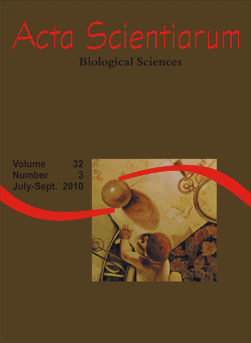<b>Impact of the invasion of <em>Prosopis juliflora</em> (Sw.) DC. (Fabaceae) in areas of Caatinga in the state of Paraiba, Brazil</b> - doi: 10.4025/actascibiolsci.v32i3.4535
Keywords:
biological invasion, Prosopis juliflora (Sw.) DC., algaroba, loss of phytodiversity, caatinga
Abstract
It is estimated that invader populations of algaroba Prosopis juliflora (Sw.) DC. (Fabaceae) in the northeastern semi-arid, Brazil, cover more than one million ha. This study aimed to study the impacts of P. juliflora invasion on phytodiversity and on the structure of the shrub-tree component in caatinga fragments in Paraiba state. Four environments were sampled by plots in which all shrub-tree individuals were surveyed and measured, estimating structural parameters of the communities. Diversity was estimated by the Shannon-Wiener index (H'), and the index of environmental impacts of exotic species (IIAE) was also calculated. A total of 19 families, 35 genera and 39 species were surveyed. Invader species accounted for more than 70% of the entire structure of the surveyed environments. The low diversity and the high environmental impact indexes obtained, as well as the structure of populations on the invaded communities, reveal that native communities are seriously jeopardized by P. juliflora. Interventions aiming at effective control of P. juliflora are recommended to protect the genetic heritage of native species.Downloads
Download data is not yet available.
Published
2010-09-13
How to Cite
Andrade, L. A. de, Fabricante, J. R., & Oliveira, F. X. de. (2010). <b>Impact of the invasion of <em>Prosopis juliflora</em> (Sw.) DC. (Fabaceae) in areas of Caatinga in the state of Paraiba, Brazil</b> - doi: 10.4025/actascibiolsci.v32i3.4535. Acta Scientiarum. Biological Sciences, 32(3), 249-255. https://doi.org/10.4025/actascibiolsci.v32i3.4535
Issue
Section
Ecology and Limnology
DECLARATION OF ORIGINALITY AND COPYRIGHTS
I Declare that current article is original and has not been submitted for publication, in part or in whole, to any other national or international journal.
The copyrights belong exclusively to the authors. Published content is licensed under Creative Commons Attribution 4.0 (CC BY 4.0) guidelines, which allows sharing (copy and distribution of the material in any medium or format) and adaptation (remix, transform, and build upon the material) for any purpose, even commercially, under the terms of attribution.
Read this link for further information on how to use CC BY 4.0 properly.
0.6
2019CiteScore
31st percentile
Powered by 

0.6
2019CiteScore
31st percentile
Powered by 











1.png)




3.png)













